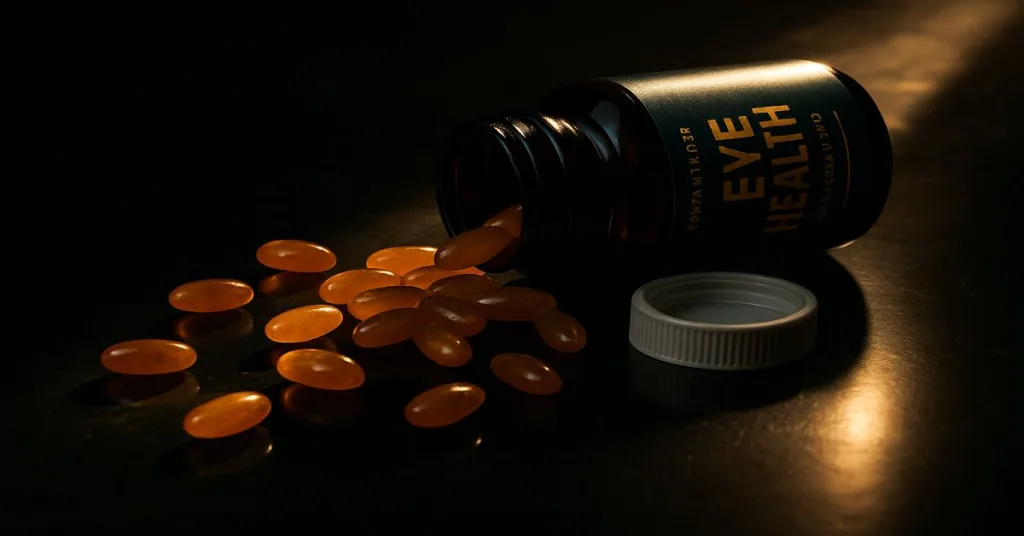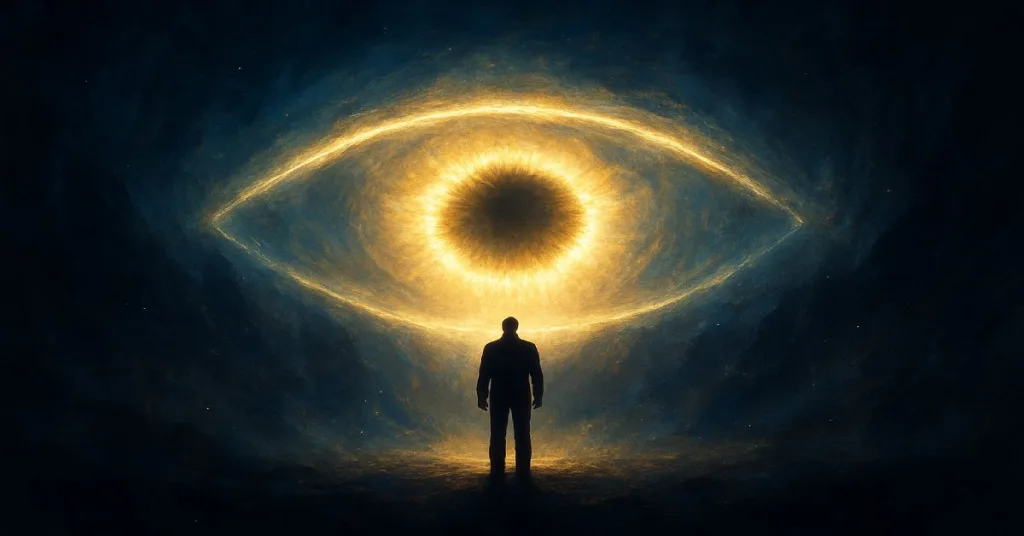The Truth Behind the Eye Supplement Boom
If your feed is suddenly full of “miracle eye vitamins,” you’re not imagining it.
From YouTube ads promising to “restore lost vision” to Facebook claims of “natural retina repair,” the supplement industry has found its newest gold mine: aging eyes.
It sounds comforting — take a capsule, keep your sight, avoid surgery. But like most health trends that blow up overnight, the reality is more complicated.
Some eye supplements do have solid clinical backing.
Most, however, ride on borrowed credibility and clever marketing.
If you’ve been seeing ads for eye supplements for macular degeneration, you’ve probably wondered whether any of them actually work or if it’s just marketing hype.
Let’s separate what actually works from what’s just label polish.
This post may contain affiliate links. If you buy through them, we may earn a small commission at no extra cost to you. We only recommend products backed by science and transparency.
Why Eye Health Became Big Business
Vision loss is one of the most feared parts of aging.
Age-related macular degeneration (AMD) affects over 11 million Americans, and that number will double by 2050. Cataracts, dry eye, and diabetic eye damage add to the anxiety — and the opportunity for marketers.
Eye supplement sales now top $2 billion annually in the U.S. alone.
The formulas promise protection from blue light, screen strain, oxidation, and even “cellular repair.”
But the real scientific backbone of this category traces to just one source: the AREDS studies funded by the National Eye Institute.

The Only Proven Formula: AREDS & AREDS2
The Age-Related Eye Disease Studies (AREDS and AREDS2) are the reason the phrase “clinically proven eye formula” even exists.
- AREDS (2001): Found that a specific combination of vitamin C (500 mg), vitamin E (400 IU), beta-carotene (15 mg), zinc (80 mg), and copper (2 mg) slowed the progression of intermediate AMD by about 25%.
- AREDS2 (2013): Updated the formula by replacing beta-carotene with lutein (10 mg) and zeaxanthin (2 mg), since beta-carotene increased lung cancer risk in smokers. Omega-3s were tested but didn’t add measurable benefit.
Those two studies remain the gold standard. They showed benefit only in people with existing moderate AMD — not in healthy eyes, and not as a cure.
In plain English: AREDS2 helps slow damage, it doesn’t reverse it.
What’s Inside the Real Science-Backed Mix
✅ Proven ingredients (AREDS2):
- Vitamin C – 500 mg
- Vitamin E – 400 IU
- Lutein – 10 mg
- Zeaxanthin – 2 mg (The original AREDS2 formula contained 10 mg lutein and 2 mg zeaxanthin, though most modern eye supplements for macular degeneration now include both lutein and at least 4 mg of zeaxanthin in the same blend, thanks to standardized marigold extracts — so there’s no need to purchase them separately.)
- Zinc – 80 mg (as zinc oxide). (AREDS2 compared 80 mg versus 25 mg of zinc and found no difference in protection. Because of that, most current eye formulas use 30–50 mg of zinc, which is considered both safe and effective alongside 2 mg of copper to maintain balance.)
- Copper – 2 mg (Copper was originally added to the AREDS and AREDS2 formulas as cupric oxide — not for vision benefits, but to prevent zinc-related copper deficiency. Modern AREDS2 supplements still include about 2 mg of copper, usually as cupric oxide, gluconate, or citrate, and the form makes little difference.)
AREDS2 tested 80 mg versus 25 mg zinc and didn’t find a clear difference in protection. The National Eye Institute still lists the classic 80 mg zinc + 2 mg copper combo, but some products — and some health authorities — use lower zinc. Talk to your eye doctor about which is appropriate for you.
If a label brags about “vision restoration” but swaps those doses for “proprietary blends” of 27 herbs — skip it.
🚫 Common gimmicks:
- “Blue light defense” claims — no credible long-term human data.
- “Super lutein complex” — often underdosed compared to AREDS2.
- “Omega-3 vision shield” — mixed evidence, may help dry eye but not AMD.
- “Bilberry extract for night vision” — almost entirely anecdotal.
How AREDS2 Actually Helps
The macula — the center of the retina responsible for sharp vision — is vulnerable to oxidative stress over decades of light exposure and metabolic wear.
AREDS2’s antioxidant and carotenoid blend helps slow that oxidative damage, maintaining the pigment layer and delaying progression to late-stage AMD.
It’s a protective effect, not a repair kit. Think of it as adding armor, not growing back what’s gone.
Who Should Consider an Eye Supplement
Good candidates:
- People diagnosed with intermediate AMD
- Those with advanced AMD in one eye
- Individuals with poor dietary intake of lutein and zeaxanthin
Not useful for:
- People with normal eyes hoping for “prevention”
- Anyone expecting “vision restoration”
- Smokers still taking beta-carotene formulas (unsafe)
Your ophthalmologist can confirm your stage and whether an AREDS2-type product is appropriate.

Brands That Follow the Actual Research
Some brands closely replicate the AREDS2 formulation.
Always verify ingredient doses against the list above.
- PreserVision AREDS 2 (Bausch + Lomb) — direct formula match, used in follow-up studies.
- Ocuvite Eye Health Formula (Bausch + Lomb) — contains lutein/zeaxanthin but lower antioxidant doses.
- Life Extension MacuGuard Ocular Support — adds meso-zeaxanthin and astaxanthin; not part of AREDS but under study.
- NOW Clinical Strength Eye Support — uses AREDS-like carotenoid ratios at lower zinc levels.
When evaluating, ignore marketing terms like “restores clarity,” “supports night vision,” or “reverses damage.” None of those outcomes were demonstrated in trials.
Emerging Ingredients (and Whether They Matter)
🧬 Meso-zeaxanthin:
Naturally present in the macula and sometimes added alongside lutein/zeaxanthin. Early data suggest it may increase macular pigment density, but evidence is still limited.
💧 Omega-3s (DHA/EPA):
May relieve dry-eye symptoms, but large trials found no prevention or slowing of AMD.
🌿 Herbs & “superfruits”:
Bilberry, goji, saffron, and astaxanthin appear in dozens of “eye blends.”
Some lab studies look promising, but there are no large, consistent human trials proving real-world benefit.
The Marketing Red Flags to Watch For
- “Reverse macular degeneration” — false; no supplement reverses existing damage.
- “Clinically proven miracle” — only AREDS/AREDS2 are proven, not most private formulas.
- “Doctor’s secret” or “military discovery” ads — fabricated authority.
- “Blue light detox” — catchy, but meaningless in medical literature.
- “Works for everyone” — impossible; AREDS applies to specific AMD stages.
If an ad needs a dramatic backstory more than it cites data, assume fiction.
The Risk Nobody Mentions
Because supplements are unregulated, many commercial “eye health” products don’t actually contain the labeled doses.
A VA study tested multiple top sellers and found that only a minority matched the AREDS or AREDS2 nutrient levels. Others were underdosed or contained untested extras.
More isn’t better — and sometimes it’s worse.
High zinc doses can cause copper deficiency; beta-carotene can harm smokers; and excessive antioxidants can interfere with normal cell signaling.
What to Do Instead of Panic-Buying Eye Pills
- Get a real diagnosis.
A dilated eye exam determines whether AMD is early, intermediate, or advanced. Supplements only matter in that middle zone. - Eat like the AREDS2 formula in food form.
- Spinach, kale, and collards → lutein and zeaxanthin
- Orange bell peppers → zeaxanthin
- Citrus and berries → vitamin C
- Nuts and seeds → vitamin E and zinc
- Quit smoking, control blood pressure, and protect eyes from UV.
Lifestyle still beats pills every time. - If you do supplement, choose verified brands (USP or NSF tested) that match AREDS2 exactly.
When Supplements Might Be Worth It
If your doctor confirms intermediate AMD, you’re in the sweet spot for evidence-based benefit.
For others, especially people with healthy eyes and balanced diets, supplements offer little beyond peace of mind — and a lighter wallet.
Think of it like sunscreen for your retina: useful after you’ve been told you’re at risk, not before you hit the beach.
The Bottom Line
- Yes, a specific formula (AREDS2) can slow AMD progression.
- No, supplements can’t reverse existing vision loss.
- Yes, many brands exploit that research to sell watered-down copies.
- No, “blue light” and “detox” blends aren’t validated science.
If you take one lesson from all this, let it be this:
Trust data, not taglines.
Your eyes deserve more than marketing.
see also: Supplements 101: A Complete Beginner’s Guide to Building a Safe & Effective Routine